|
She linked these
Green Men
to 'Jack
in the Green'* figures,
of British May Day celebrations
In 1978, Kathleen Basford
generated further interest with her acclaimed book,
"The
Green Man",
a monograph of these odd and sometimes demonic looking faces.
From these and
a few other sources, here is a little of what we do know :
The earliest known carving of a
Green Man
is said to be from India, dating c2300 BC.
It is thought that
perhaps
both far-Asian and European
Green Men depictions
derived from these middle eastern sources,
passing into textiles,
thence into Coptic painting and textiles, ending up in western manuscripts -
and medieval 'architecture' (our particular aspect).
The earliest
Green Man found
in 'church architecture' dates c400 AD,
from St. Abre, in St. Hilaire-le-grand, France.
(And below is even a
Roman Green Man mosaic, dating possibly to the 6th century
reign of Byzantine Emperor Justinian I, Great Palace Mosaic Museum, Istanbul.)
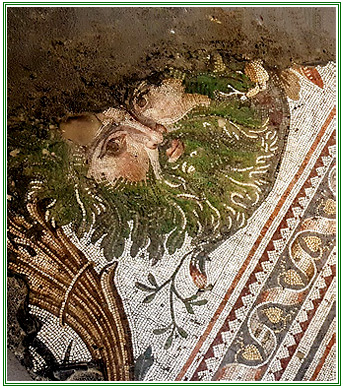
And ... there are indeed
'Green Women' - those considered quite rare.
(We had one that unfortunately sold before it could be photographed).
As well, there are 'Green Beasts', often very
'animal', some with snubbed noses and high pointed ears.
'Green Men','Women' - and 'Beasts'
- are at best ambivalent, having various shades of meaning.
Some are even thought to have demonic references -
as the 'root of
all evil', or
'lost souls of the demon woods'.
However the general association remains :
nature and its cycles of life
'regeneration' and 'renewal'
tending our 'green world'.
So with the passing of the 2020
'Vernal Equinox',
we begin this season of
'renewal' ...
off, however, to a REALLY
REALLY ROCKY start!
It occurred to me that the bizarre or grotesque expressions on these faces
might be
somewhat akin to our
own - right now.
Pick your twin ...
However, within
these grimaces you might also find a wee bit of
'Celtic-like'
humor -
the kind bringing that lilt and
'seed of laughter',
making all seem right with the world ** -
even if only for a moment - or two.
OUR COLLECTION : PLEASE CLICK ON THE IMAGES FOR THE DETAIL PAGE
Should you have interest, please email.
The gallery is closed to the public for the time being.
However we are still quite agile with internet
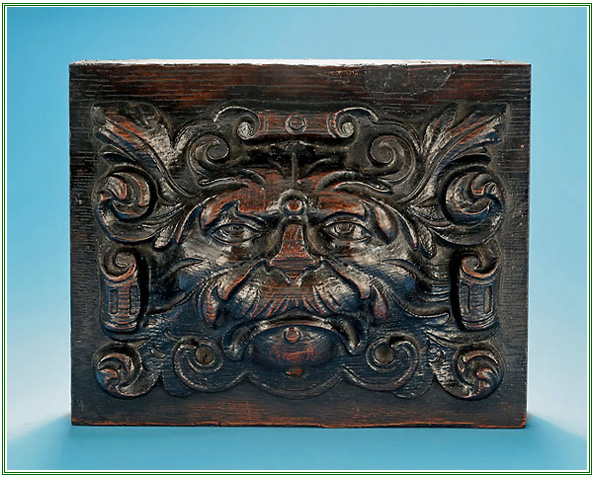
Carved Oak Green Man (or Beast)
The well carved face emerging from foliage
having a with snub nose,
as characteristic of some beast forms; a deep heavy block
Probably 19th century
6-3/4" High x 8-5/8" Wide x 2-1/2" Deep
/ #7633-5
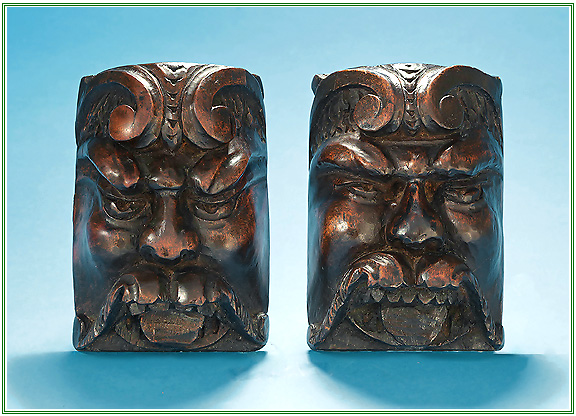
Pair of Carved Treen Green Man Corbel Appliqués
Each crowned with foliage and having foliate moustaches,
upper and lower teeth showing and with tongues extended
19th Century
5" High x 3-12" Wide 2" Deep /
#7633-3
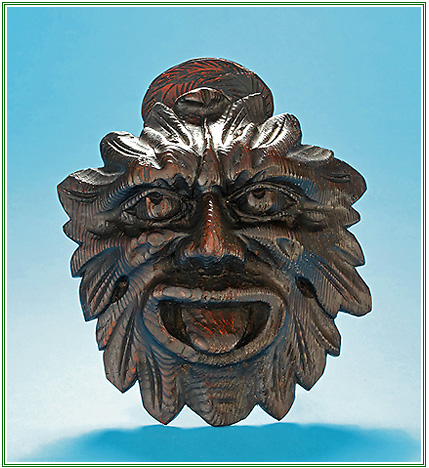
Carved Oak Green Man
The head and features emerging from foliage,
eyes rolled upward, the open mouth with tongue extended
Probably 19th Century
8" High x 6-1.4" Wide x 2" Deep / #7633-1 / SOLD
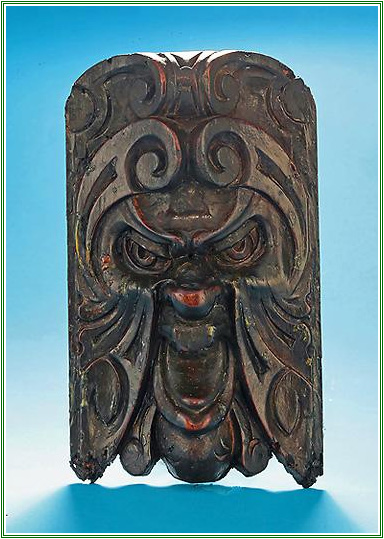
Carved Treen Green Man
The elongated face emerging from scrolled foliage,
a bulbous nose, the mouth open wide showing bottom teeth and extended tongue
19th Century
Some erosion and losses at bottom & verso
9" High x 5" Wide x 2" Deep / #7633-8
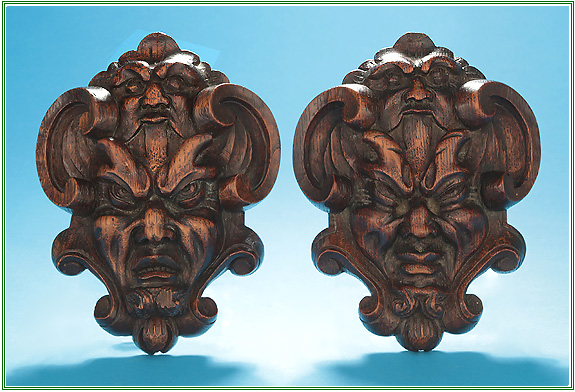
Pair of Well Carved Mahogany Green Men
Each having a horned Pan or demonic type face,
and surmounted by
a second foliate face with long tongue extended;
C-scrolled sided head and beard
Probably 19th Century
6-1/2" High x 5-1/2" Wide x 1-1/2" Deep /
#7633-2
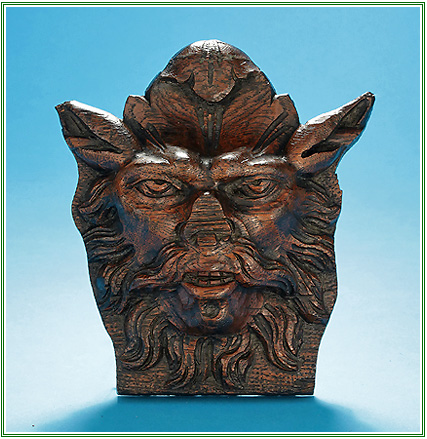
Carved Oak Green Man (Green Beast)
Having high pointed ears, snub nose and slightly open mouth,
the top of the head arising from foliage,
the lower part bearded
Probably 19th Century
7" High x 6-1/4" Wide x 2-1/2" Deep / #7633-7
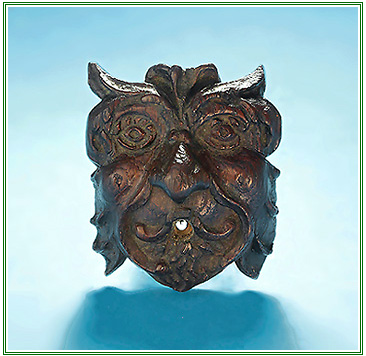
Small Carved Oak Green Man (Green Beast) Boss
The face arising from foliage and
having a bulbous nose;
scrolled cheeks and moustache, and carved eyelashes,
the mouth pierced through
(likely for a screw attachment)
19th Century or Earlier
3-1/4" High x 3" Wide x 1-1/2" Deep / #7633-4 / SOLD
A Wee Bit of
'Green Man'
Trivia :
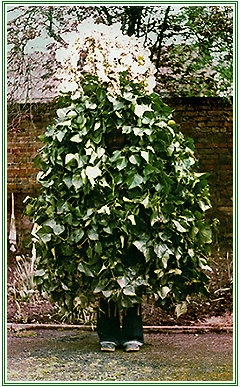
* Jack in the Green
- a conical wicker or wooden frame decorated with foliage,
worn in a procession often accompanied by musicians
(see image above).
The Green Man
first appeared in the Oxford English Dictionary in 1531.
Shakespeare's play 'The Merry Wives of Windsor'
had its premiere April 23, 1597,
during which Herne the Hunter, the mystical figure that has been associated
with the
Green Man, made his appearance.
The English mythological figure
Robin Goodfellow
is linked with the
Green Man,
also known as 'Puck'
from Shakespeare's 'Mid Summer-Nights Dream'.
He is said to be a
mischievous nature sprite, his Welsh equivalent,
pwca, or
Irish pixie.
The
Green Man
is
associated with hero
Robinhood,
as they both
lived in the woods
and
dressed in green.
Peter Pan
is yet another
Green Man figure.
**
In relation to the Green Man carvings
is an ancient Celtic custom of burying the dead
with an acorn in the mouth, which would later sprout into a tree.
This recalls the legend of Seth and the Tree of Life :
when Adam was on his deathbed, Seth returned to the Garden
and begged the Angel guardian to let him have a seed.
This Seth placed in Adam's mouth.
The seed later grew into a Tree, which by a 'circuitous route'
became the Tree from which the wood was taken for the Crucifixion.
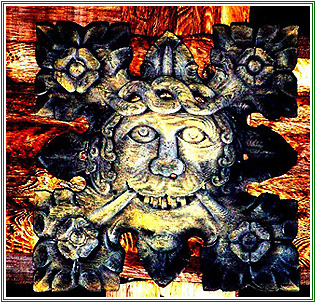
Durham Cathedral, St Mary and St Cuthbert, Durham, England.
One of 16 wooden bosses in the cloisters
Green Man Capital, St. Jerome's Church, John Lord, Flickr
St. Jerome's Church, Llangwym, WikiCommons
Roman Green Man Mosaic, Great Palace Mosaic Museum, Istanbul; Disdero, WikiCommons
Green Man, Durham Cathedral, St Mary and St Cuthbert, Durham, England, WikiDot / Flickr
Stock Photography : Millicent Creech
|